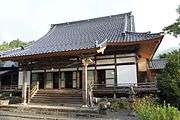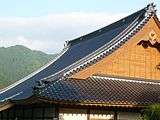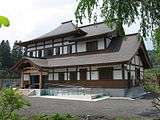Shonenji Temple, Takachiho
Coordinates: 32°45′39.45″N 131°16′47.29″E / 32.7609583°N 131.2798028°E
| Shonen-ji | |
|---|---|
 | |
| Basic information | |
| Location | Kamino 2771, Takachiho-chō, Nishiusuki-gun, Miyazaki 882-1411 |
| Affiliation | Jōdo Shinshū |
| Country | Japan |
| Architectural description | |
| Founder | Tanio Yoshimura |
| Completed | 1578 |
Shonen-ji (正念寺 Temple of the Correct Nembutsu) is a temple of the Jōdo Shinshū (Pure Land) school of Buddhism. It is located in Takachiho Town,[1] Miyazaki, on Kyūshū, Japan's southernmost main island.
The Shonen-ji temple complex is situated at the base of Genbuzan mountain, about 12 km outside central Takachiho. It was established there in 1578 by Tanio Yoshimura following the destruction of Genbu-jo, the Yoshimura clan's castle. Genbu-jo was burned and the principal Yoshimura family members killed when the Christian daimyo, Ōtomo Sōrin, invaded from Bungo Province in the north.[2] According to temple records, Tanio Yoshimura experienced a revelation following the loss of the castle and then committed himself and his successors to a religious life in atonement for the many deaths that had occurred.[3]
In accordance with Jōdo Shinshū tradition, the position of head priest at Shonen-ji is hereditary through the eldest son. The present head priest, Junsho Yoshimura (b. 1958), is the seventeenth generation of his family to serve at Shonen-ji. Shonen-ji is unique (June 2011) among Japanese temples in that the English wife of the head priest is herself an ordained Kiyoshi (senior priest).[4][5][6]
In May 2006, Shonen-ji established a branch temple in the Kishinoue section of central Takachiho. The Kishinoue Kaikan (see image below) includes a meeting hall, a mausoleum, and an English school.
Principal Buildings
Takachiho-cho
- A Shōrō-mon (鐘楼門 bell tower gate) stands at the main entrance to the temple. In 1978, a new bell was installed to mark the 400th anniversary of Shonen-ji's founding. The tower itself was rebuilt as a 3x2 ken (bay) structure in 1986.
- Shonen-ji's Hon-dō (本堂 main hall) measures 7x7 ken (bays). The hall has been destroyed by fire twice in its history. The present structure dates from the early 20th century.
- Nokotsu-dō (Mausoleum) 3x2 ken
- Kaikan (Meeting Hall). Opened in December 2000.
- Community Hall
Central Takachiho
- Kishinoue Kaikan (Branch temple, mausoleum, and English school) in the Kishinoue section of central Takachiho.
Gallery
.jpg) Shonen-ji's Main Entrance
Shonen-ji's Main Entrance.jpg) Shōrō-mon seen from the courtyard
Shōrō-mon seen from the courtyard Shonen-ji Hon-dō (Main Hall)
Shonen-ji Hon-dō (Main Hall) Main Hall (roof detail)
Main Hall (roof detail) Shonen-ji Kishinoue Kaikan
Shonen-ji Kishinoue Kaikan
See also
- Takachiho Town
- Amanoiwato-jinja - Shinto shrine
References
- ↑ Takachiho Town is also the location of Ama-no-Iwato Jinja, the Shinto shrine protecting the cave where, according to Japanese legend, the sun goddess Amaterasu hid after battle with her brother, plunging the world into darkness until lured out by the spirit of merriment Ame-no-Uzume.
- ↑ For more details of Ōtomo's exploits, see: Sansom, George (1961). A History of Japan, 1334-1615. Stanford, Calif.: Stanford Univ. Press. p. 464. ISBN 978-0-8047-0525-7.
- ↑ For more information on Shonen-ji's early history, see pp. 156-7 in 甲斐, 亮典 (2008). 東臼杵西臼杵の歴史. 郷土出版社. p. 246. ISBN 978-4-87663-976-2.
- ↑ Kris Kosaka (February 21, 2009). "Living life like a fairy tale". Japan Times Online. Retrieved March 17, 2014.
- ↑ "Ginger Buddha (Video)". Daily Motion. Retrieved June 8, 2011.
- ↑ "British Woman is Japanese Buddhist Priest". Japanese Culture and Language. February 21, 2009. Retrieved June 8, 2011.
Further reading
- Hongwanji International Center (2002). Jodo Shinshu : A Guide. Kyoto, Japan: Hongwanji International Center. p. 174. ISBN 4-89416-984-3.
External links
- Shonen-ji Temple, Takachiho - Official Site (English)
- Jodo Shinshu Hongwanji-ha - Official Site (English)
- Takachiho Tourism Site (English)
 Takachiho travel guide from Wikivoyage
Takachiho travel guide from Wikivoyage
| Wikimedia Commons has media related to Shonen-ji. |